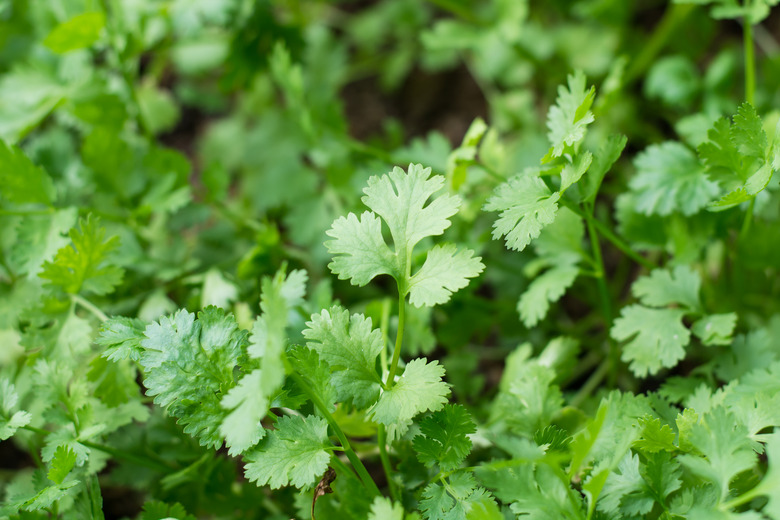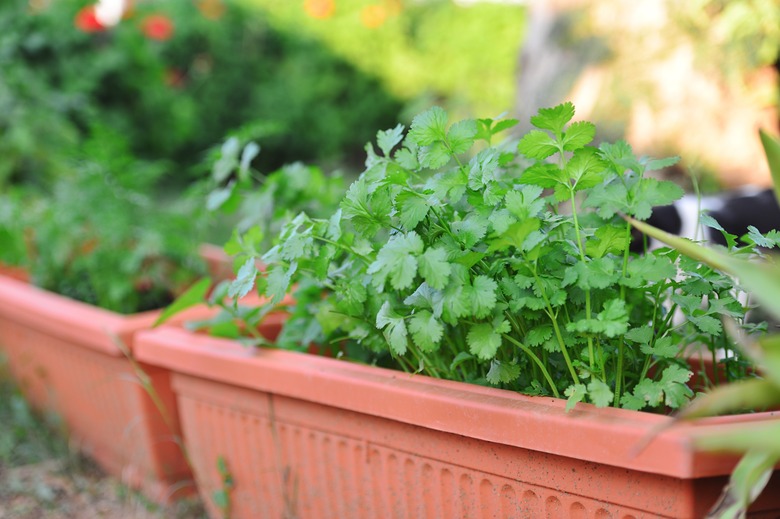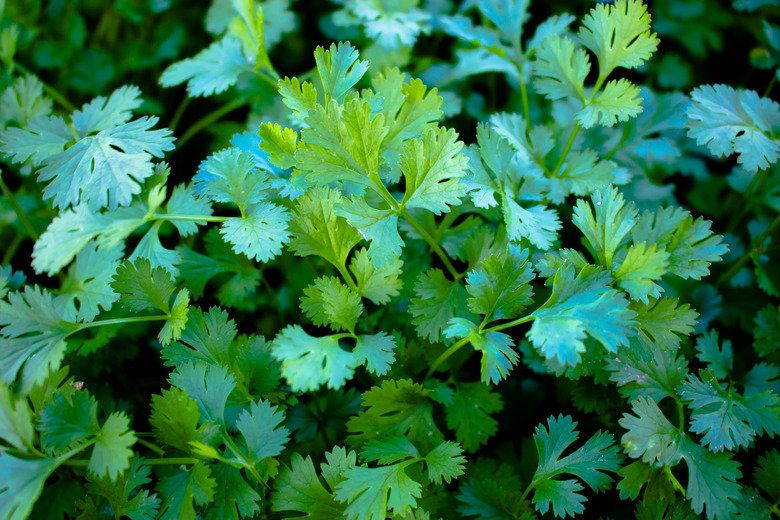How To Grow Cilantro
We may receive a commission on purchases made from links.
Cilantro (Coriandrum sativum) is a well-known annual herb that is a favorite in the garden as well as the kitchen, giving an earthy, citrusy flavor to soups, salsas, Mexican dishes and Indian cuisine. The plant actually produces both cilantro (the leaves) and coriander (the seeds). A bushy plant that has both decorative and culinary value, cilantro grows best in fairly cool weather and is fairly low maintenance in terms of care. It grows quite quickly and can be harvested repeatedly once the leaves have grown in a bit. This plant is also sometimes referred to as Chinese parsley.
The cilantro plant is related to many other garden favorites in the Apiaceae plant family. Carrots, celery and parsley are relatives as well as parsnips, fennel and dill. Characteristics of these plants include a taproot, hollow stems and groupings of flowers on the top of the plant. Many of them have a scent, and cilantro is among those that have a pleasing smell.
Best Uses for Cilantro
Best Uses for Cilantro
Cilantro has a place in many a gardener's plot and with good reason. This tasty herb is used in a huge range of food dishes, and it is a popular recipe item. Fresh cilantro is often spotted in Mexican toppings such as guacamole or salsa, and it is a key ingredient in many Asian and Latin American recipes as well. A versatile herb, it has been employed as a garnish, mixed into dressings, served with fish and much more. It can even be frozen or dried for later use if there's a good crop at harvest time.
Fresh cilantro has a unique taste that sets it apart from other herbs. Some describe it as peppery, while others note a citrus-like taste. Interestingly, there are a number of people who dislike the taste of cilantro, and this is due to genetics. For these people, cilantro tastes more like soap than a delicious herb.
Cilantro can be potted and/or grown anywhere in the yard where there is ample sun. It makes an attractive addition to nearly any space, as the leaves of the plant are quite pretty. Plants that are allowed to fully mature will produce pink, white or pale-purple flowers. In addition, the way it grows is bushy, so it will fill a decorative pot well. Because of its appearance, cilantro can be grown in a garden, in the front yard or in a pot on the patio. The leaves also smell good, so locating the plant on a deck or a front porch can also be an unexpected way to add a dash of greenery.
How to Grow Cilantro
How to Grow Cilantro
- Common Name: Cilantro
- Botanical Name: Coriandrum sativum
- When to Plant: Spring or late summer
- USDA Zones: Grown as an annual in zones 2-11
- Sun Exposure: Full sun to part shade in warmer climates
- Soil Type: Well-drained soil
- When it's in Trouble: Hot weather can cause bolting, which is when the plant produces flowers and sets seed
- When it's Thriving: Plentiful bushy, green leaves
Starting Cilantro From Seed
Sow seeds 1 to 2 inches apart at a depth of about 1/2 inch. Leave a foot between the rows to allow for growth and air circulation. Water well initially until the seeds germinate. Seeds can be sown in containers for a sunny windowsill herb garden, but growing this herb inside in a pot and then transplanting it into the garden is not ideal. Cilantro has a taproot and doesn't like to have that disturbed once it is established. Seeds can be purchased online or at a local garden store or nursery.
In What Zone Does Cilantro Grow Best?
In What Zone Does Cilantro Grow Best?
Cilantro is a good herb to plant anywhere in USDA plant hardiness zones 2 through 11. It perform well in cooler weather, although it's best to avoid frost if at all possible. Seeds will germinate in soil starting at about 55 degrees Fahrenheit. The plant can be grown indoors as well as long as it receives plenty of sun. Be sure to keep in mind that if you want to grow this plant indoors in the winter, you will probably have to use a grow light.
When Should You Plant Cilantro?
When Should You Plant Cilantro?
Cilantro prefers cooler weather, so it should be planted in the spring. That said, it's also possible (and recommended) to stagger plantings of this herb if it will be harvested frequently, as this will help extend the growing season. Space plantings a few weeks apart to have plenty to harvest on an ongoing basis. Cilantro can also be planted in late summer for harvesting in the fall. Wait until after the heat of the summer has dissipated before sowing seeds in the soil. The plant is usually ready for a light first harvest somewhere around the 40-day mark depending on the variety.
Soil, Sunlight and Water Recommendations for Cilantro
Soil, Sunlight and Water Recommendations for Cilantro
Cilantro is a resilient herb that does well in a cool, dry environment. It tolerates some heat but benefits from light shade in the heat of the day if planted in warmer climate zones. That said, the plant requires good sun to grow well, so full shade won't work in terms of location. Cilantro can grow up to 2 feet high, so keep that in mind as well when mapping out the location for this planting in the garden or yard.
In order to do well, cilantro requires about an inch of water per week as a seedling, so supplement accordingly if there isn't enough rain. When the plant has matured, be sure to let the soil dry out a bit between waterings, as the moisture needs of the herb will have diminished. The cilantro plant likes well-draining soil, so be sure not to overwater. Some fertilizer can be used to support growth but don't overdo it; supplementing once or twice a season should be more than enough. When grown inside, simply fertilize with a bit of diluted fish emulsion or a fertilizer that is made for edible plants to make sure it has enough nutrients to grow properly.
Mulch is key for the cilantro plant, as it helps to cool the soil temperature and keeps the plant from bolting early. It also cuts down on weeds and helps to protect the roots of the plant. Remember that mulch holds moisture as well, so be sure to take that into account when evaluating the watering needs of the plant.
How to Harvest Cilantro
How to Harvest Cilantro
Although this herb can be grown inside, indoor plants tend not to be as prolific as ones that are grown in the garden. When harvesting cilantro from plantings that have been grown indoors, be sure to pinch leaves frequently to encourage a bushier form.
For garden plants, keep in mind that regular harvesting will help extend the crop, preventing it from bolting early. Cut the leaves with the stems from the top of the herb, leaving about 2/3 of the plant down low intact to continue growing. Use a sharp knife or garden shears to help keep the plant as healthy as possible. Harvest leaves off the stem after rinsing. If you need just a few leaves for garnishing or if you don't mind doing a bit of work outside, pinch leaves off individually.
Grocery store cilantro is a full harvest of the plant, which is also possible. If you decide to go this route, then there won't be more leaves to harvest from that point forward for the season. Choose the method that works best for your needs.
Although cilantro is an annual, it is possible for it to reseed itself in the garden if it is left to grow. This can mean new plants for the following spring without having to purchase new seeds. If desired, feel free to let some of the plants flower fully so they will develop seeds that will then drop into the ground. As an additional harvest, the coriander (seeds) can be removed before they drop and saved for use in recipes as well. Once they turn brown, take them off the plant and put them in a paper bag until they dry completely.
Common Pests and Other Problems for Cilantro
Common Pests and Other Problems for Cilantro
One of the primary issues often experienced with growing cilantro is bolting. The plant has a fairly short growing season when it comes to harvesting leaves. When the weather heats up and temperatures get high, this plant goes to seed very quickly, making the leaves less tasty and not good for a harvest. To prevent this, plant the herb in spring, late summer or early fall depending on climate zones and weather conditions in the region. Also, use mulch to keep the soil cooler.
Harvesting some of the leaves each week can also help keep the plant from bolting. If you don't catch things in time, just let the plant bloom and go to seed, as the leaves are pretty much beyond saving at that point for use in recipes. It's also an excellent idea to purchase varieties of this herb that are slow to bolt. Some of the options include Long Standing and Costa Rica cultivars. Check with your local garden center to see what is recommended in your region.
Aphids can sometimes be a problem for cilantro plants. Control them by spraying the bugs off the plant with water in the early part of the day so the sun will dry the leaves quickly. Another way to control these pests is by using an organic insecticidal soap that is suitable for garden vegetables and herbs. Cabbage loopers can also affect cilantro plants. Remove these by hand if they are found.
Common Diseases of Cilantro
Common Diseases of Cilantro
Cilantro is remarkably unaffected by many of the diseases that can ravage other garden plants. However, it can suffer from a number of different problems if there is too much moisture, so watering carefully is an important preventative measure for this particular plant. Wet soil or water sitting on stems and leaves can contribute to rot, wilt and other problems that can spoil a good crop of leaves. Keep an eye out for any browning or yellowing as a sign of problems. The plant can also suffer from powdery mildew, which looks like a light white dusting on the tops of leaves.
Luckily, most of these issues can be avoided by simply letting the soil dry slightly between waterings and making sure not to spray the plant when irrigating. In heavy clay soils with poor drainage, it may make more sense to plant cilantro in raised beds so the roots don't sit in water.


